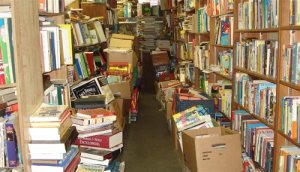 Occasionally I’ll crowdsource, as it were, a childhood memory. I was born and grew up in Oshawa, Ontario, living there between 1957 and 1976. Other than brief work-related stays from December 1983 to September 1984, and again from June to September 1992, I haven’t lived there since 1976, some 46 years ago. So when I needed help recalling a particular used and rare books dealer, my go-to place for research was the private Facebook group Vintage Oshawa, which has about 19,400 members and describes itself as “a place to post pictures, memorabilia & share tales of Oshawa past (pre-1980).” After all, 19,400 heads might be better than one in this case, I reasoned. And I had success almost four years ago back in May 2018 when I asked in classic Facebook style “who remembers” Rose Bowl Fish and Chips that operated at the corner of Bond and Prince streets? More than 200 members of the group either liked the question or responded with a comment.
Occasionally I’ll crowdsource, as it were, a childhood memory. I was born and grew up in Oshawa, Ontario, living there between 1957 and 1976. Other than brief work-related stays from December 1983 to September 1984, and again from June to September 1992, I haven’t lived there since 1976, some 46 years ago. So when I needed help recalling a particular used and rare books dealer, my go-to place for research was the private Facebook group Vintage Oshawa, which has about 19,400 members and describes itself as “a place to post pictures, memorabilia & share tales of Oshawa past (pre-1980).” After all, 19,400 heads might be better than one in this case, I reasoned. And I had success almost four years ago back in May 2018 when I asked in classic Facebook style “who remembers” Rose Bowl Fish and Chips that operated at the corner of Bond and Prince streets? More than 200 members of the group either liked the question or responded with a comment.
How we consolidate, access and sometimes geographically transpose locations in long-term memory is a complex process beyond the ken of my knowledge of neuroscience, but here is what I asked earlier today based on what I suspected to be a real but perhaps flawed memory:
“Does anyone recall a used bookstore on Division Street in Oshawa in the 1970s and 1980s, not far from the old General Motors North Plant? Brown brick, I think, like other buildings in the neighbourhood. A bit dingy in terms of lighting inside but not without its charms. I think the name might have started with the letter M, but it was all quite a while ago. Given that we’re talking about 40 or 50 years ago, it’s also possible I’ve conflated the idea of a bookstore on Division Street in the area of the GM North Plant with a health food/Asian vegetable market store in that location and the bookstore was on the west side of Simcoe Street South, near John Street East, not far south of a Pepi’s Pizza location on that corner. I still have fond, though distant memories of my friend Mike Byrne, working there as a cook in high school circa 1973-74, and wrangling his friends the odd late-night pie … the pepperoni pizza … greasy, yes, sure. But superb also.
The mention of Pepi’s Pizza was perhaps not essential to answering the question, given the focus is on a bookstore and Asian grocery store, but mentioning a favourite childhood eatery in Oshawa, be it Pepi’s or Mother’s Pizza Parlour and Spaghetti House, or perhaps Red Barn or Burger Chef, always is a good memory prompt for any even tangentially related story I’ve found as a writer.
So what did I learn today from folks in Vintage Oshawa? When I said, I think the name might have started with the letter M,” turns out I was correct as dozens of readers spelled it out for me as Morgan Self, which I instantly knew as correct. But commenters went well beyond that in their help. Apparently, there were two Morgan Selfs who were proprietors of their … err … self-named bookstore, father and son. And they lived on Shakespeare Avenue another commenter noted (their bookstore was at 84 Simcoe St. S.) Now, I confess my fact-checking skills as a blogger aren’t perhaps as well-honed as they had to be as a pre-Google and pre-Wikipedia copy editor on the rim at daily newspapers, but I just had to Google Shakespeare Avenue to make sure this was by the book and there was such a street in Oshawa (I didn’t recall it) and I wasn’t being audaciously pranked on social media prior to April 1. Turns out to be legit. There is such a street. Whether the book-selling Selfs lived on it would take more verification for a newspaper back in the day, but for us present-day bloggers, not so much. Editors in their day were the last-line-of-defence fact checkers. When you wear a writer’s hat, you are a storyteller and there’s an admonition that a writer should never let the facts stand in the way of a good story. This was true even before 2017 when Sean Spicer came along and elevated the notion to high principle. That said, the photograph accompanying this post is admittedly for illustration purposes only. It is not the inside of the long-gone Morgan Self bookstore in Oshawa. At least I think it’s not.
You can also follow me on Twitter at: https://twitter.com/jwbarker22
Tag Archives: Editors
Who’d a thunk it? Readers says it’s a toss-up when it comes to whether robo-journalists write better than human journalists
OK … we’ve all heard the phrase “fishwrap” applied derogatorily by critics assessing the quality of newspapers wherever they live from time to time. Methinks some weeks that does a disservice to how my favourite pickerel from Paint Lake should be treated, but it isn’t just local newspapers that are problematically bad at times. Take the venerable Associated Press, affectionately known by working journos simply as the AP. They managed to move this alert last Wednesday: “BC-APNewsAlert/17. New York Yankees Hall of Fame catcher Yogi Bear has died. He was 90.” Actually, Yogi Bear, the beloved Hanna-Barbera cartoon character is only 57. He was created in 1958, making his début as a supporting character in The Huckleberry Hound Show, and was the first breakout character created by Hanna-Barbera and was eventually more popular than Huckleberry Hound.
Yogi Berra, the beloved baseball player, on the other hand, was created in 1924 and born in 1925. A native of St. Louis, Berra signed with the New York Yankees in 1943 before serving in the U.S. Navy in the Second World War. He made his major league début in 1946 and was a stalwart in the Yankees’ lineup during the team’s championship years in the 1940s and 1950s.
Berra was a power hitter and strong defensive catcher. He caught Yankees’ pitcher Don Larsen’s perfect game on Oct. 8, 1956, in Game 5 of the 1956 World Series against the Brooklyn Dodgers, the only perfect game in Major League Baseball (MLB) post-season history. After playing 18 seasons with the Yankees, Berra retired following the 1963 season. Berra was also famous for his string of truisms, tautologies and malapropisms, including “Nobody goes there any more; it’s too crowded,” along with, “It ain’t over til it’s over” or, “Anyone who is popular is bound to be disliked,” as well as, “Half the lies they tell about me aren’t true” and, “If you ask me anything I don’t know, I’m not going to answer.” My personal favourite, which I managed to inject into several columns, editorials or news stories over the years, was the well-known, “This is like déjà vu all over again,” which I had used again as recently as Aug. 24, less than a month before Yogi Berra died.
It was while I was pondering how a boo boo like the Yogi Bear/Yogi Berra obituary mix-up happens in journalism (I suspect the eagle-eyed Ranger John Francis Smith from Jellystone Park would have known the difference) that I came across the latest information on robo-journalism (not to be mixed up with Tory robo-calls during the 2011 federal election campaign, I should point out to my friends still remaining in Canadian journalism.) Turns out that unlike most human journalists, who are for the most part seriously mathematically challenged, robot journalists that already work for such illustrious newspapers as the New York Times and Los Angeles Times, as well as Forbes, the storied business magazine, have shown a natural aptitude for data, making them ideal for the sports and business desks, and as such are now about ready to branch out into breaking news and investigative journalism.
Neil Sharman (believed to be a human writer) and former head of research and insight at Telegraph Media Group on Buckingham Palace Road in London, writing Sept. 22 in TheMediaBriefing, also based in London, noted that robots, “Like junior reporters … can learn from and draw on a back catalogue of great writing – but with more powerful memories and analytical techniques.” You can read Sharman’s full piece here: http://www.themediabriefing.com/article/robo-journalism-the-future-is-arriving-quickly
“Machines are adept at investigating data sets,” Sharman says. “Publishers have set them to tax records, homicide data, meteorological reports and more –looking for patterns and describing them. They’re thorough, not prone to error and they’re fast.
“The LA Times uses robo-journalism to break news about earthquakes because machines can analyse geological survey data faster than a human. It takes under five minutes to spot a story and get it online.”
Tim Adams, a staff writer for the “The Observer: The New Review” at London’s The Guardian newspaper, wrote a piece June 28 on Kris Hammond, a professor of journalism and computer science at Northwestern University and co-founder and chief scientist at Chicago-based Narrative Science, which developed a writing program for robots known as “Quill.” Hammond also founded the University of Chicago’s Artificial Intelligence Laboratory. He told Adams, “we are humanizing the machine and giving it the ability not only to look at data but, based on general ideas of what is important and a close understanding of who the audience is, we are giving it the tools to know how to tell us stories.”
Adams observes, “It’s not deathless prose – at least not yet; the machines are still ‘learning’ day by day how to write effectively – but it’s already good enough to replace the jobs once done by wire reporters. Narrative Science’s computers provide daily market reports for Forbes as well sports reports for the Big Ten sports network. Hammond predicts that 90 per cent of journalism will be written by computer by 2030. Automated Insights, one of Narrative Sciences competitors, based in Durham, North Carolina, does all the data-based stock reports for AP.
Adams also notes that “last year, a Swedish media professor, Christer Clerwall, conducted the first proper blind study into how sports reports written by computers and by humans compared. Readers taking part in the study suggested, on the whole, that the reports written by human sports journalists were slightly more accessible and enjoyable, but that those written by computer seemed a little more informative and trustworthy.”
Clerwall, an assistant professor in media and communication studies at Karlstad University in Karlstad, Sweden concluded that “perhaps the most interesting result in the study is that there are [almost] no… significant differences in how the two texts are perceived.”
In terms of narrative arcs, Hammond says, “Like any decent hack, the machine is coming to learn that there are only five or six compelling tales available: back from the brink, outrageous fortune, sudden catastrophe and so on.”
You can also follow me on Twitter at: https://twitter.com/jwbarker22


